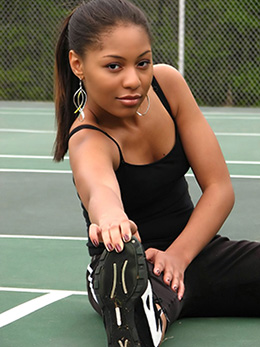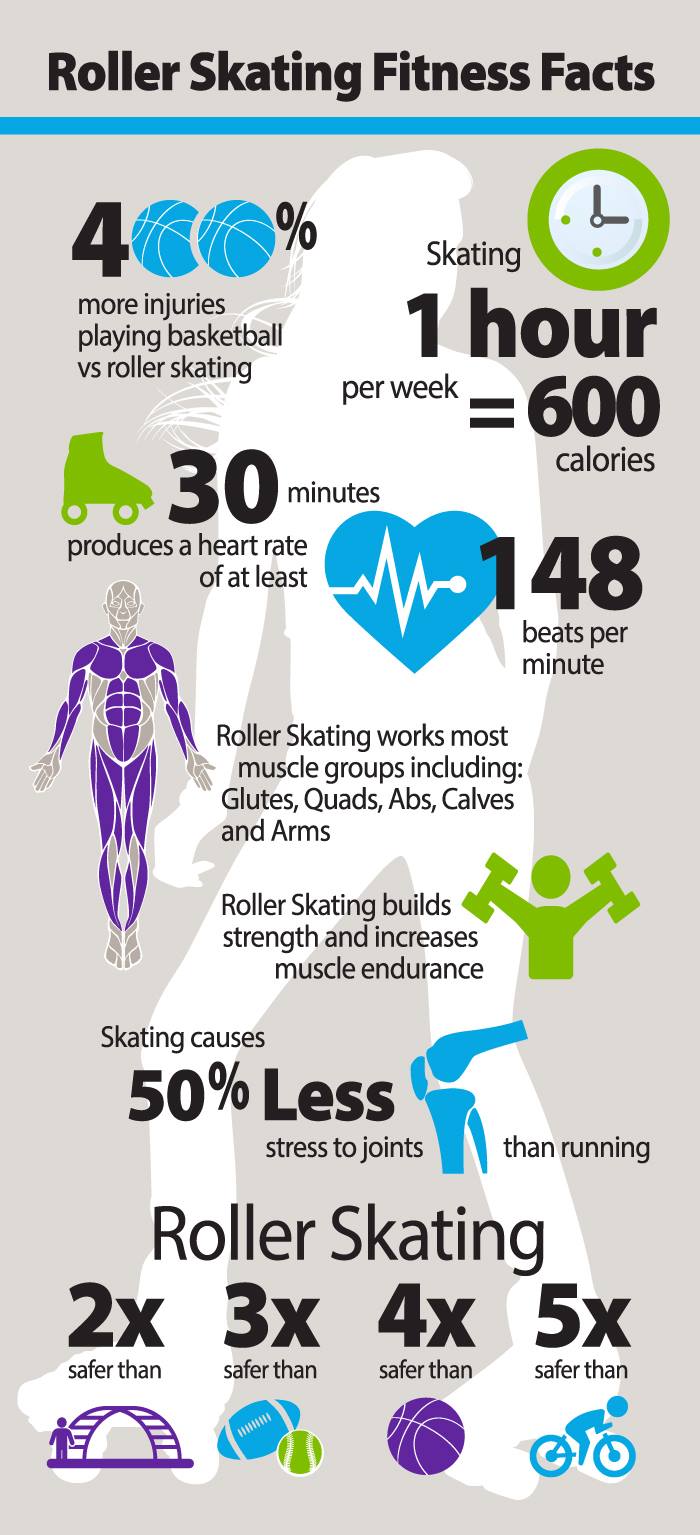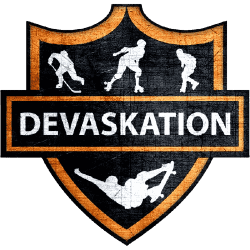

Who wouldn’t want to skate? We have no idea! You may be looking for a fun way to get fit or you might be a skater that wants more ways to stay fit. You’ve come to the right place, this article has it all! Professional skaters agree that regardless of your age, build, or even the type of skating you do, that it is essential to maintain a routine workout during both on- and off-season. A fitness regimen to fit your personal needs is ideal in order to maintain your strength, health, and endurance for all types of skaters.
“The stronger you are, the less likely you are to break!” – Rocky Whore’r, Derby Skating BadA$$
This routine should ideally include: warm-ups before skating, stretching after skating, and maintaining a fitness routine when you are not actively skating. Following these steps will allow any skater to achieve maximum results and make for a healthy lifestyle overall.
This article is meant for anyone who has skated, does skate, or wants to skate. No matter where you fit into that, there is something here for you! You can start with what gear you’ll need or if you already have some, move right into why you really want to skate, how to warm up, and tons of excercises both on, and off your skates.
So start your warmup here with some great information on where to start, how to get and stay fit, and most importantly, how to stay safe so you can keep skating as much as we know you want to.
What Do I Need to Get Started?
Know Your Type
First, decide whether or not you would like to use roller blades (inlines) or traditional roller skates (quad skates). You know the ones — they have 4 wheels in a square… These skates are ideal for beginners because of their larger base surface area which makes them more stable and easier to balance on. Inline skates have wheels in a straight line with a brake sometimes attached to the back heel. More advanced skaters usually use these, but it is perfectly fine to try either!
Skate Boots
Make sure your boots are snug in the toe and the heel. We see people buying skates a “little larger than they need” all the time, presumably in an effort to save a few dollars on buying a new pair of skates in the future (This is fine for kiddos! We’ll explain later…). This can lead to poor form in us larger than minion humans, which will inevitably lead to injury and blisters. If your foot slips in the shoe, it’s too big. When going to stop on your quad skate toe stops, if the boot is too big, your toes will jam forward and ram into the toe of the boot. This can cause the loss of toe nails, and yes, it is as bad as that sounds. Wearing thick socks or more than one pair won’t work either. If you’re an adult, you’ve stopped growing (sorry?) and buying a size up is unnecessary. You wouldn’t buy chucks or a fancy pair of heels that are too big, so don’t do it with your skates. Kids skates are a different story. More on that here.
Wheels
Of course, you can always contact us if you have ANY questions about skates, wheels, or the meaning of life (no promises on the meaning of life responses though, we’re a sarcastic bunch). As a general rule on skate wheels, the taller and thinner wheels are made to go fast, without the stability a wider wheel can provide. Usually, skating newbies succeed with quad skates and wide wheels because they feel comfortable learning with the utmost stability. Skate enough and you’ll want to go fast! When that happens, don’t get a whole new setup. Switching out parts is super easy and we have the videos to prove it!
Safety Gear
Never forget to invest in safety gear when skating ANYWHERE! Knee pads, elbow pads, a helmet, wrist guards, mouth guards – invest in whatever will prevent an injury. If you’re looking for basic safety gear, we suggest wrist guards (when we fall, our go-to is to put our palms to the pavement) and a helmet to protect you brain…you only get one of these!
A Little Time
You’re not going to look like a pro your first time out. Stop being so hard on yourself! Let yourself fall and get tired in three minutes. It gets easier, we promise. Before you know it, you’ll wanna be trickin’, racin’, and cruisin’. Heck…you might even try out for your local Roller Derby team or start a rad skate park gang.
So, what are we learning today? Skating provides the same benefits as jogging – calorie burn, muscle toning, and aerobic exercise. The difference is that many people skate for leisure and find it to be very fun – especially because they can enjoy it with friends and family of all ages. Get started with great skate products and packages! Feel free to contact us so that we can answer all of your questions.
What Can I Do That Is Fun While Exercising?
Many people equate exercise with punishment or torture – or simply an inconveniece to their schedules. If you don’t like your exercise regimen, chances are you won’t stick to it. A great way to boost your fitness regimen and keep you jazzed is, in fact, SKATING! Roller skating or rollerblading is a fun, low-impact way to get great exercise. The idea of skating may seem daunting for some, but hear us out. It is perfect for all ages and levels of fitness, easy on your joints, and most importantly, it’s a pastime you can enjoy with anyone, anywhere. And the health benefits are incredible!
Whether you feel more comfortable on quad skates or inline skates, and either inside on a skate rink or out on the town cruisin’ down the sidewalk, this is something super fun and easy that takes little practice.
Benefits of Skating
Skating Burns Calories and Increases Muscle Tone! Roller skating provides the same health benefits as jogging, if you can believe it. It’s a great all around workout. It reduces body fat, burns calories, builds leg strength, and improves balance and overall mood (endorphins man!). The reason that cardiovascular excercises help people lose weight quickly is because your legs are the largest muscles in your whole body. This means that as you build leg muscles (by doing things like skating), you increase your metabolism, which makes your body burn calories quickly (even when in resting mode).
Skating Is Low-Impact
Those who run as a primary exercise activity are at risk for injury in their knees, ankles, joints, muscles, feet, and more. Many people cannot run due to a past injury or a health issue of some kind. The stress on your joints when skating is 50% less than someone who jogs or runs, but you get the same cardiovascular benefit in the same amount of time. Skating is a great option for those with bad knees, arthritis, foot afflictions, etc.
Full-Body Workout!
Skating works not only your legs, but also your hip muscles (important to keep strong, especially as you age), thighs, and shins. Skating also tones and tightens your core. It’s one of the best ways to keep a toned tummy, that can be hard to work out. You’ll even sculpt your inner and outer thighs, which, for many, are considered “trouble spots.” The most important thing is, “Strong is the new Skinny.” Be active and we promise you’ll love life!
The Importance of Warming Up Pre-Skate
Warming up before a skate or cardiovascular exercise has many benefits. For any skater, the major benefits of a warm-up include an increase in your strength, speed, and range of motion. A warm-up sends increased blood and oxygen to joints and muscles, making them more flexible and lubricated, which decreases the chance of muscle tear, strained ligament, and injuries overall.
Muscles and joints are much more limber after warming up. This prevents muscle tears and ligament strains, and leaves you feeling flexible and limber. Skaters that warm up before competing or skating reduce their chance of injury due to a sudden fall or quick movement compared to those that don’t. If you skate in cold weather, such as an outdoor skater or figure skater, it is even more important to warm up your already cold muscles and extremities.
Not warming up correctly leaves any skater at risk for a pulled or strained muscle – which can have a long-term impact, and keep you off the rink/track for months! Experts say that any athlete that uses their legs the most, including skaters, are more susceptible to injuries from not warming up than any other types of athletes. This is why pre-workouts are considered an important safety practice for roller derby. Skaters who are older are also more susceptible to injury due to not warming up than younger ones, as the muscles are typically not as flexible.
“Pre-Hab” On Skate Warm-Up for Roller Derby Skaters
One popular routine for roller derby skaters is known as a Pre-Hab or On-Skate warm up. Doing each of the following movements while on skates for 15-20 seconds before practice or competition will get your legs and core warmed up and ready for your Roller Derby skating awesomeness! Exercises included in Pre-Hab/On-Skates are: squats, squat touch right, squat touch left, side to side lunges, bum kicks, toy soldiers, slaloms in both forward and reverse direction of skating, jogging on skates, grapevines, drunken crossovers, windmills, arm swings, neck mobility movements, torso circles, and more.
No matter what type of skating you participate in, it is essential to have a routine of warming up, practicing during the off-season, and stretching, in order to prevent injury and to always perform at your very best!
Skate the Weight Off!

An awesome way to keeping your New Year’s Resolution to lose weight and exercise, plus stay healthy, happy, slim, and trim all year long is here!
As January quickly comes and goes, we look back on our New Year’s resolution (or if you were really ambitious, maybe more than just one) and we reflect.
- Am I enjoying more family time and working less?
- Did I quit smoking?
- Am I going back to school to further my education or career?
Many of us have resolved to start the New Year with goals of losing weight, exercising, or generally being more healthy and active. We ask ourselves, “Have I started exercising? Am I sticking to a fitness regimen? Am I eating well?” We all want to be better at something and fitness is on the top of the list for many of our customers.
In fact, 66% of Americans who make New Year’s resolutions focus them on staying fit or healthy, to include exercise and weight loss. Almost 90% of people who make resolutions to exercise in order to lose weight or improve their health don’t follow through. This is mainly because they don’t have a fitness or diet plan in place.
Need even more reasons to skate? Check out the infographic to learn all kinds of fun fitness facts about skating (according to the Consumer Product Safety Commission) including that roller skating is:
- 2x safer than school playgrounds
- 3x safer than football or baseball
- 4x safer than basketball
- 5x safer than riding a bicycle
Well, the SECRET to following through on your resolution to stay fit and strong with exercise and fitness is something we have for you in this article! And it’s FUN, no seriously, we promise it’s way more fun than many exercises you might try along with your New Year resolutions. So, now that you’re convinced you’re going to have so much fun you won’t believe it’s exercise, check out the recommended workouts and exercises below that you can add on to your loads of skating time!!
Recommended Workouts for Roller Skaters
Skating the track while not competing or engaged in your normal routine of speed skating, artistic skating, roller derby skating, etc. is beneficial to your success in whatever type of skating you are in. All levels and types of skaters practice and work out differently, due to the varying nature of skating sports. Practice makes perfect.
Types of Workout Drills for Skaters
There are many different moves that are beneficial to skating that can be done both on and off the track. Some of these moves include full squats, half squats (keeping thighs parallel to the ground), crab walks, and focused practice laps.
Squats
Squats are a great overall exercise; while skating, skaters are activating their core and thier main muscle groups i.e. quads and glutes. Holding squats for a minute or more develops muscle memory and increases strength and balance throughout the leg.
Tiptoe Through the Tulips
Some skaters do an exercise known as “Tiptoe Through the Tulips”. This is when skaters walk on their toe stops for a lap (or more) and alternate jogging on their skates. Alternating one lap at a time is recommended to start, and once this becomes very easy, one can increase the intensity of the workout by increasing the number of laps around a the track before switching exercises.
Skating in the Opposite Direction
Some professional skaters do their warm-ups and workouts skating in the opposite direction that they usually skate in. This is so they can even out the muscle tissue and eliminate left- or right-turn tendencies – This is a REAL thing!!
Roller Derby skaters in particular should follow a regimen of warming up before competing, and stretching after skating. Due to the intensity of Roller Derby skating, it is recommended that warming up before practice and competitions is crucial.
Roller Derby Exercises
Roller Derby Stretches
In order to maintain the cardiovascular endurance needed to withstand the intensity of Roller Derby skating, practice, and competitions, it is recommended that certain exercise and fitness regimens are in place. Roller Derby can absolutely help you gain a healthier lifestyle. However, it is a good idea to have a fitness ‘base’ prior to engaging in the sport, in order to maintain energy.
Recommendations regarding Roller Derby exercises may need variation based upon your body type, size, and/or other health factors. The general recommendation is to be sure to include aerobic exercise, strength training, and stretching. All of these play a huge roll in your Roller Derby success. The more you give to Derby, the more you’ll receive.
It is also important to remember to take time off during training. Most Roller Derby experts agree that taking a day off between workouts, in order to allow for muscle recovery, is important. If you are just starting a fitness routine you may want to take off more time. As always, consult a physician in regards to any injuries, medical conditions, or concerns prior to starting any physical fitness regime or as needed.
Cardiovascular Endurance
Roller Derby requires the ability to skate for long periods of time. In order to gain speed and be able to endure a session of Roller Derby, cardiovascular or aerobic exercise is important to your exercise regimen. Doing aerobic exercise 3-5 days per week for 20-60 minutes is the baseline for cardiovascular endurance sufficient for a Roller Derby skating fitness level. To kick it up a notch, and to see results more quickly, Roller Derby enthusiasts suggest doing intervals of high intensity aerobic exercise. Performing aerobic exercise at a high speed or rate (for example, sprinting instead of slowly jogging) in intervals of 20 seconds to 2 minutes followed by 10 seconds to 3 minutes of recovery (rest) is a popular method.
Strength Training
There are many exercises that increase strength that can be done at home, at the gym, and even on skates! Specifically, floor exercises for legs and abs can be performed with skates, which add extra weight, making for more of a challenge and improved results.
Exercises such as squats, lunges, leg presses, toe presses, and calf raises are common strength training exercises ideal to improve overall performance and strength while participating in Roller Derby skating. It is important to research form and technique for strength exercises, as doing them with incorrect form is not only potentially dangerous, but also will not give you the results you are looking for.
Performing core or abdominal exercise is suggested for overall stability and strength on the track. When performing core or ab strength exercises, it is important to remember to balance the work on your abs with doing exercises for your back as well. (This is VERY important!! Overall body balance!!)
Roller Derby skaters have also found it important not to ignore upper body strength exercises. Keeping a strong upper body assists in overall balance and makes for a more complete, full-body workout.
Stretching
Stretching is important before and after workouts, so as to avoid muscle cramping. Roller Derby skaters recommend stretching every day if possible. Do it!!
Once you are ready to get on the track, look to DevaSkation.com as your trusted provider in derby skates!
